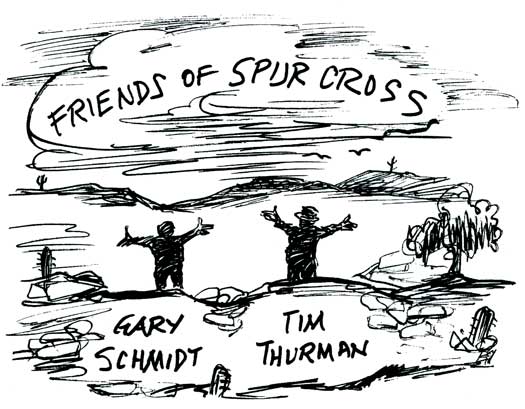'MY VIEW' BY DON SORCHYCH | AUGUST 10, 2011

Spur Cross Ranch revisited
A recent article about Spur Cross Ranch (SCR) in the Arizona Republic invoked memories of the battle to “save” SCR. Their article ignored history and I will attempt to recall who the real heroes and bums were.
First of all, when the town survives by imposing incredibly high water rates and other measures to keep the town functioning who of us doesn’t wonder whether a resort on that scenic 2,154 acres wouldn’t be a boon to the local economy?
The sacrifices necessary to pay off the bond certainly will be worth it to future generations and those who worship the Sonoran Desert with all its grandeur and wildlife.
Remember the good times when homebuilders suffered the huge impact fees when building a house? Impact fees slowed growth while filling the town bank account. The recession was a huge shock and the town, so used to a loaded treasury, had to scramble to survive.
The town responded to the need to buy Herb Dreiseszun 30 percent of SCR in record numbers with more than three fourths of the voters passing the bond, funded by a secondary property tax, which is now scheduled to be paid off on June 30, 2012.
But how did we get there? Not with Mayor Vincent Francia and Town Manager Usama Abujbarah shaking hands of potential voters as the Republic article states. The successful bond vote preceded both of them.

The group that deserves the most credit is “Friends of Spur Cross.” The two founders of this aggressive organization were Gary Schmidt and Tim Thurman.
Both had coincidentally attended a planning meeting at town hall and they were offended that Chairman Dennis Wilenchik had a conflict of interest as the attorney for a developer who planned a golf resort on SCR. According to them he told the audience he would recuse himself but stayed on as chairman and supported the resort's plans.
I advised them to contact an activist named Barry DiSimone and they did.
They formed Friends of Spur Cross, with Schmidt as president and DiSimone, Thurman and Gail Clements as board members.
Their formidable organization grew rapidly as the word got around. Schmidt had a phone tree of several people who would each call 10 people if they got word from him to do so.
So meetings and mobilization of volunteers was virtually instant. Frequent trips were arranged for politicians to see SCR Indian sites and petroglyphs. There were explanations of how golf holes were planned on Indian burial sites.
I went on one such visit with Sen. John McCain and the head of the Hopi Tribe. Both were impressed and supported preservation for SCR.
McCain said he would support the preservation if everyone in the area were supportive.
Later, McCain dropped support when an influential land preservation group sent a letter dropping support.
A land trade was considered with Tonto National Forest, but the feds undermined that option.
The town administration and council were actively supporting the purchase of SCR. The mayor at that time was Tom Augherton. He and others worked to annex SCR and a substantial amount of property south of SCR needed to vote for annexation. Although people living in that area liked being unincorporated, they were convinced to vote for the greater good, the eventual purchase of their scenic backdrop, SCR.
Politically connected, Augherton (he was the Director of Administration for Attorney General Grant Woods) convinced Governor Jane Hull to purchase SCR and she did, but unfortunately missed the fact that the land was owned by American Insurance Company and Herb Dreiseszug with a 70/30 undivided interest.
Hull even sat in the gallery with her best Governor’s glare to push the vote to a successful conclusion, and it was, for $15 million.
A lobbyist for Great American Insurance was heard to say, with a chuckle, "Well we have our $15 million; Good luck on the rest." The $15 million was to come from the state of Arizona and Maricopa County, which left Cave Creek to negotiate with Dreiseszun for the remaining 30 percent.
Another strong advocate for SCR was Norman Foster. Norman owned the Victorian home and Phoenix Gold Mine that was the entrance to SCR. He kept an album of all the articles that appeared about SCR and once told me 90 percent of the clippings were from Sonoran News.
Foster, his daughter and son moved to Colorado after selling his property, where he passed away.
Gary Birnbaum, a partner in the Mariscal Weeks law firm was hired to come up with purchase terms.
He eventually consummated a deal, town council approved it and then later a $6,825 million bond vote was held on Sept. 12, 2000.
The appetite for property taxes never ceases among bureaucrats though. With the final payments for SCR being only eight months away Town Manager Usama Abujbarah began sowing the idea of another property tax about the amount of SCR’s to pay for fire protection. He and Mayor Vincent Francia were surprised when the idea to put property taxes to a vote failed by one vote.
Now Abujbarah is selling use of a portion of the three percent sales tax and a property tax for half the required amount. This is a thicket that needs study. I personally paid Rural/Metro $1,100 this year and I would rather do that than have a property tax. On the other hand Rural/Metro should fund a marketing program to get more subscribers and lower subscription cost.
Property tax should remain verboten!


